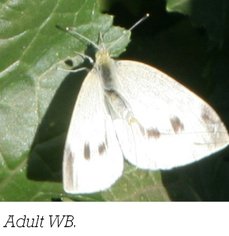White butterfly
White butterfly (WB) is found throughout NZ. The caterpillar causes damage by feeding on the leaves of brassica crops.
Identification
The adult WB has four broad cream to white coloured wings with black spots and a grey to black body. The female has two pairs of black spots on the forewings, while the male has one pair of spots. Their bodies are about 20 mm long with a wingspan around 50 mm.

Female lay 300-400 eggs on the underside of leaves of the host plant. They are laid singularly on more than one plant, initially creamy white but changing to orange just before they hatch.
The caterpillars are dull green with small hairs giving a velvety appearance. There are five larval stages, during which they grow from
2 mm to 30 mm in length. In later stages, an orange-yellow stripe can be seen along the back. Caterpillars can be differentiated from diamondback moth in their behaviour, being quite aggressive when disturbed. This is in comparison with diamondback moth larvae which 'run away', often dropping off the leaf onto the ground after being disturbed.
Caterpillars feed on the outer, older leaves of the brassica crop initially, but as they grow move into the centre of the plant. Feeding commences from the leaf margin towards the central leaf vein, with feeding damage mainly occurring from October to May.
WB pupa are around 15 mm long, with a hardened outer shell and gain protection by hiding where their colour blends in with the background (i.e. in leaf litter or on fence posts or sheds).

Prevention and management
Natural predators like hoverflies, harvestman and parasitic wasps can keep WB populations in check.
Good seed-bed preparation helps prevent infestation, because the removal of old brassica crop debris prevents over-wintering and localised build up in
paddocks.
If damage is apparent insecticides can be effective in the control of WB

